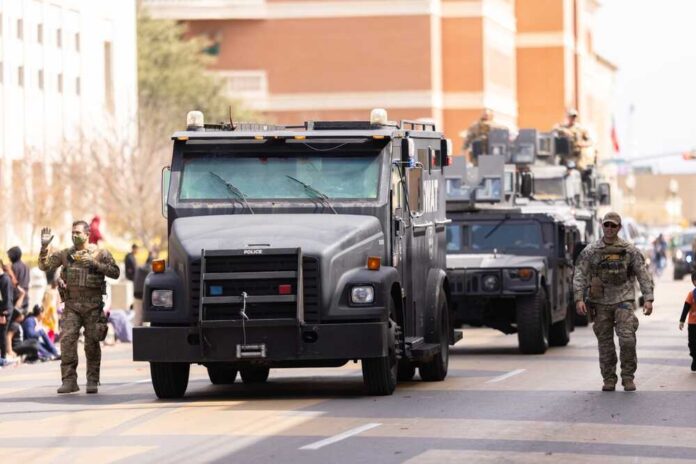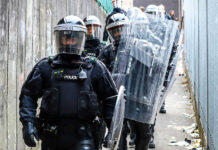
(RightWingJournal.com) – Surveillance footage exposed a jaw-dropping jewelry heist by an armed mob in California, leaving behind $1 million in shattered glass and unanswered questions about organized retail crime’s relentless rise.
Story Snapshot
- Nearly two dozen masked suspects stormed Heller Jewelers in San Ramon, California, smashing display cases and stealing $1 million in merchandise.
- The coordinated mob wielded guns and heavy tools, firing a shot and threatening employees before escaping in waiting vehicles.
- Several suspects were apprehended later that day, but the incident highlights the resource challenges facing law enforcement.
- Retail theft in California is escalating, impacting public safety, local economies, and prompting new anti-crime task forces.
Organized Retail Crime Hits Affluent California
Heller Jewelers, nestled in San Ramon’s upscale City Center Bishop Ranch, became an unwilling stage for one of California’s most audacious retail crimes. On September 22, 2025, nearly 25 masked suspects burst into the store, wielding hammers, pickaxes, and firearms. Surveillance video captured the mob smashing display cases and scooping up high-value jewels. At least one suspect fired a shot through the entrance, while others menaced employees with weapons, amplifying fear and chaos. The criminals fled in multiple vehicles, launching a police pursuit that was ultimately called off for helicopter tracking, revealing law enforcement’s tactical constraints against such large-scale, coordinated attacks.
California’s surge in organized retail theft has become a defining issue for businesses and policy makers. Statewide, these smash-and-grab robberies have soared 93% since 2019, hitting luxury retailers and local shops alike. Just weeks prior, Kim Hung Jewelry in San Jose faced a similar attack, injuring its elderly owner and echoing the growing sense of vulnerability among store owners. The escalating boldness and sophistication of these criminal rings challenge traditional policing and motivate the formation of specialized task forces, such as the California Highway Patrol’s Organized Retail Crime Task Force.
Law Enforcement Faces Resource and Tactical Challenges
San Ramon Police and state authorities responded swiftly, detaining several suspects in Oakland and neighboring communities later that day. Yet the scale and speed of the heist exposed ongoing challenges: law enforcement agencies must contend with criminals who outnumber them, move in coordinated waves, and exploit quick getaways. The incident’s clarity, caught on high-definition surveillance, enabled rapid identification and arrest of suspects like Jimmy Ray and Michael Ray. However, with most of the mob still at large, the investigation continues, fueled by public tips and media coverage.
Governor Gavin Newsom and police chiefs have publicly reaffirmed their commitment to combating organized retail crime. In 2025 alone, California’s task force has made over 700 arrests and recovered $8 million in stolen goods, yet the sheer frequency and value of these heists suggest the problem is far from contained. Law enforcement leaders emphasize the need for robust multi-agency cooperation, smarter surveillance, and faster response times. Criminologists point to economic pressures and the influence of organized crime networks as key drivers behind these increasingly brazen acts.
Economic and Social Fallout Reverberates Across California
The immediate impact on Heller Jewelers is staggering: $1 million lost, shaken staff, and an urgent need for repairs and heightened security. Local business owners throughout the Bay Area are grappling with heightened anxiety, rising insurance premiums, and pressure to invest in costly security upgrades. Retail crime contributes billions in economic losses annually in California’s progressive cities, fueling political debate and public calls for tougher sentencing and prosecution.
Store owners now face a stark choice: invest in heavy-duty security or risk being the next viral video of a smash-and-grab. The broader luxury retail sector is reassessing protocols, insurance policies, and staff training. The economic burden is compounded by social consequences, rising fear, eroding trust, and a perception that affluent communities are no longer immune to violent, organized crime. Lawmakers face mounting pressure to demonstrate real progress, balancing the need for public safety with calls to address underlying socioeconomic factors driving organized theft.
Expert Analysis and Policy Perspectives
Security experts and policy analysts underscore the growing sophistication of retail crime rings. Advanced planning, coordinated attacks, and the use of surveillance countermeasures mean that traditional store defenses are increasingly inadequate. Some experts advocate for tougher laws and longer sentences, arguing that swift, decisive justice is the best deterrent. Others emphasize the need to address root causes, unemployment, social dislocation, and the lure of fast money in organized crime.
Media outlets and police statements consistently report the same core facts: the scale of the mob, the value of stolen goods, the use of firearms, and the subsequent arrests. Minor discrepancies in suspect numbers reflect the fluid nature of ongoing investigations. Surveillance footage and eyewitness accounts provide irrefutable evidence of both the event’s boldness and the urgency for new solutions. As organized retail crime evolves, so too must the public’s response, combining common sense, conservative values, and tactical innovation to restore security in California’s hardest-hit communities.
Copyright 2025, rightwingjournal.com























